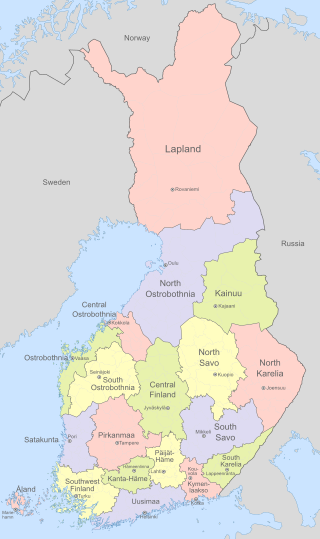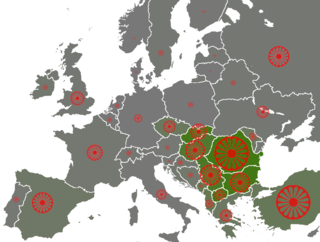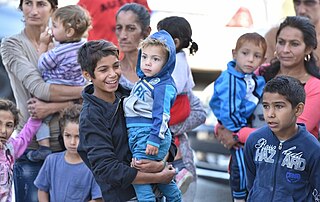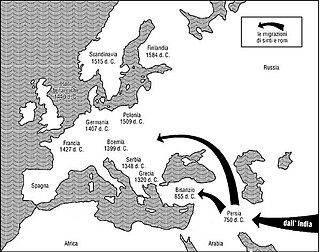Related Research Articles

Finland, officially the Republic of Finland, is a Nordic country in Northern Europe. It borders Sweden to the northwest, Norway to the north, and Russia to the east, with the Gulf of Bothnia to the west and the Gulf of Finland to the south, opposite Estonia. Finland covers an area of 338,145 square kilometres (130,559 sq mi) and has a population of 5.6 million. Helsinki is the capital and largest city. The vast majority of the population are ethnic Finns. Finnish and Swedish are the official languages, with Swedish being the native language of 5.2% of the population. Finland's climate varies from humid continental in the south to boreal in the north. The land cover is predominantly boreal forest biome, with more than 180,000 recorded lakes.

The Romani, also spelled Romany or Rromani, colloquially known as the Roma, are an Indo-Aryan ethnic group who traditionally lived a nomadic, itinerant lifestyle. Linguistic and genetic evidence suggests that the Romani originated in the Indian subcontinent; in particular, the region of present-day Rajasthan. Their subsequent westward migration, possibly in waves, is now believed by historians to have occurred around 1000 CE. Their original name is from the Sanskrit word डोम (doma) and means a member of a Dalit caste of travelling musicians and dancers. The Roma population moved west into the Persian Ghaznavid Empire and later into the Byzantine Empire. The Roma arrived in Europe around the 13th to 14th century. Although they are dispersed, their most concentrated populations are located in Europe, especially central, eastern, and southern Europe, as well as western Asia.

The Romani Holocaust or the Romani genocide was the planned effort by Nazi Germany and its World War II allies and collaborators to commit ethnic cleansing and eventually genocide against European Roma and Sinti peoples during the Holocaust era.

Finland is divided into 19 regions which are governed by regional councils that serve as forums of cooperation for the municipalities of each region. The councils are composed of delegates from the municipal councils. The main tasks of regional councils are regional planning, the development of enterprises, and education. Between 2004 and 2012, the regional council of Kainuu was elected via popular elections as part of an experimental regional administration.

Roma, traditionally Țigani, constitute one of Romania's largest minorities. According to the 2011 census, their number was 621,573 people or 3.3% of the total population, being the second-largest ethnic minority in Romania after Hungarians. There are different estimates about the size of the total population of people with Romani ancestry in Romania, varying from 4.6 per cent to over 10 percent of the population, because many people of Romani descent do not declare themselves Roma. For example, in 2007 the Council of Europe estimated that approximately 1.85 million Roma lived in Romania, based on an average between the lowest estimate and the highest estimate available at the time. This figure is equivalent to 8.32% of the population.
The Deutsche Gesellschaft für Internationale Zusammenarbeit (GIZ) GmbH, often simply shortened to GIZ, is the main German development agency. It is headquartered in Bonn and Eschborn and provides services in the field of international development cooperation and international education work. The organization's self-declared goal is to deliver effective solutions that offer people better prospects and sustainably improve their living conditions.

The World Romani Congress is a series of forums for discussion of issues relating to Roma people around the world. As of 2023, there have been eleven World Romani Congresses. Among the chief goals of these congresses have been the standardization of the Romani language, improvements in civil rights and education, preservation of the Roma culture, reparations from World War II, and international recognition of the Roma as a national minority of Indian native origin.

Romani people in Bulgaria constitute Europe's densest gypsy minority. The Romani people in Bulgaria may speak Bulgarian, Turkish or Romani, depending on the region.

Anti-Romani sentiment is a form of bigotry which consists of hostility, prejudice, discrimination, racism and xenophobia which is specifically directed at Romani people. Non-Romani itinerant groups in Europe such as the Yenish, Irish and Highland Travellers are frequently given the name "gypsy" and as a result, they are frequently confused with the Romani people. As a result, sentiments which were originally directed at the Romani people are also directed at other traveler groups and they are frequently referred to as "antigypsy" sentiments.

Stolipinovo is a district of the Bulgarian city of Plovdiv and the most populous predominantly Romani-inhabited district on the Balkans with a population of about 20,000 people. It is a ghetto located on the outskirts of the city, in its northeastern part on the right bank of the Maritsa.
The Finnish Kale are a group of the Romani people who live primarily in Finland and Sweden. Their main languages are Finnish, Swedish and Finnish Romani. Kalo/Kale is the collective name for traveler people in Finland, England and Spain.
Pavee Point (PP) is a government-funded non-governmental organisation based in Dublin, Ireland that was formed to improve the human rights of Irish Travellers and to bridge the economic and social inequalities between Travellers and settled people. Irish Travellers are an ethnic minority group that originated from nomadic tradespeople.

The Romani people have several distinct populations, the largest being the Roma and the Calé, who reached Anatolia and the Balkans in the early 12th century, from a migration out of the Indian subcontinent beginning about 1st century – 2nd century AD. They settled in the areas of present-day Turkey, Greece, Serbia, Romania, Croatia, Moldova, Bulgaria, North Macedonia, Hungary, Albania, Kosovo, Bosnia and Herzegovina, Czech Republic, Slovenia and Slovakia, by order of volume, and Spain. From the Balkans, they migrated throughout Europe and, in the nineteenth and later centuries, to the Americas. The Roma population in the United States is estimated at more than one million.
Romani people in Hungary are Hungarian citizens of Romani descent. According to the 2011 census, they comprise 3.18% of the total population, which alone makes them the largest minority in the country, although various estimations have put the number of Romani people as high as 8% of the total population. They are sometimes referred as Hungarian Gypsies, but that is considered to be a racial slur.

The Xoraxane in Bosnia and Herzegovina are the largest of the 17 national minorities in the country, although—due to the stigma attached to the label—this is often not reflected in statistics and censuses.

There have been Romani people in Croatia for more than 600 years and they are concentrated mostly in the northern regions of the country.

The Romani people, also known as the Roma, qualify as an ethnic minority group in Poland of Indo-Aryan origins. The Council of Europe regards the endonym "Roma" more appropriate when referencing the people, and "Romani" when referencing cultural characteristics. The term Cyganie is considered an exonym in Poland.

Lars Castellucci is a German politician of the Social Democratic Party of Germany (SPD) who has been serving as a member of the German Bundestag since 2013.

The European Alliance of Cities and Regions for Roma Inclusion is an initiative from the Congress of Local and Regional Authorities of the Council of Europe. The Alliance currently gathers 130 Cities and Regional authorities from 29 countries.
Miranda Vuolasranta is a Finnish Kale activist, Romani-language teacher and Roma human rights expert, who is President of the European Roma & Travellers Forum.
References
- ↑ "Romanit toimijoina yhteiskunnassa : Romaniasiain neuvottelukunta 50 vuotta -juhlajulkaisu" (in Finnish). STM. 2006. Retrieved April 8, 2022.
- ↑ "Valtakunnallinen romaniasiain neuvottelukunta RONK" (in Finnish). Retrieved April 8, 2022.
- ↑ "Valtioneuvoston asetus valtakunnallisesta romaniasiain neuvottelukunnasta ja alueellisista romaniasiain neuvottelukunnista". Finlex (in Finnish). December 4, 2003. Retrieved April 8, 2022.
- 1 2 "The National Advisory Board on Romani Affairs". Advisory Board on Romani Affairs. Retrieved April 8, 2022.
- ↑ "1980". Advisory Board on Romani Affairs (in Finnish). Retrieved April 9, 2022.